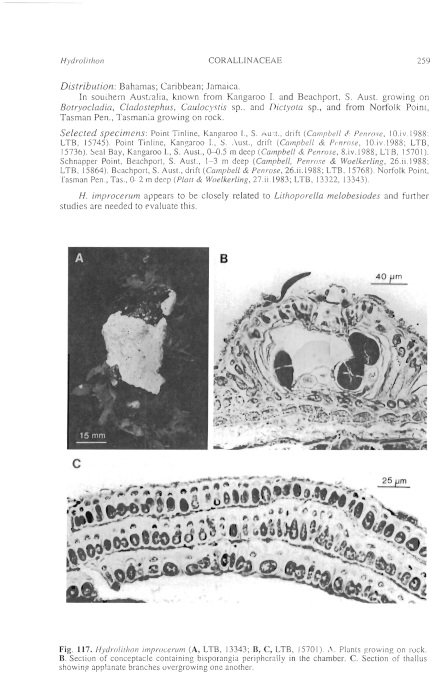|
|
|
|
|
|||||||||||
|
Electronic Flora of South Australia Species Fact Sheet
Phylum Rhodophyta – Class Florideophyceae – Order Corallinales – Family Corallinaceae – Subfamily Mastophoroideae
Synonyms
Goniolithon improcerum Foslie & Howe in Foslie 1907b: 24. Townsend & Adey 1990: 99, figs 1–41.
Porolithon improcerum (Foslie & Howe in Foslie)Howe 1920: 587.
Thallus encrusting, composed of a number of applanate branches that overgrow one another and that are attached to each other by cell adhesion and sometimes by rhizoids; epiphytic, epilithic or epizoic and affixed by cell adhesion. Structure pseudoparenchymatous; organisation dorsiventral; construction dimerous, consisting of a single ventral layer of branched filaments composed of non-palisade cells, and unicellular filaments that arise more or less perpendicularly from cells of ventral layer filaments, each filament composed of cells 5–22 µm in diameter and 5–35 µm long; epithallial cells terminating filaments at the thallus surface, distal walls rounded or flattened but not flared; cells of adjacent filaments joined by cell-fusions, secondary pit-connections absent; trichocytes occurring commonly in horizontal rows and singly at thallus surface, not becoming buried within thallus.
Reproduction: Vegetative reproduction unknown. Gametangia, carposporangia, tetrasporangia and bisporangia produced in uniporate conceptacles.
Gametangial plants monoecious; carpogonia and spermatangia produced in separate conceptacles. Carpogonia terminating 3-celled filaments arising from the female conceptacle chamber floor. Mature female-carposporangial conceptacle roofs protruding above or flush with surrounding thallus surface, composed of 2–4 cells above the chamber, conceptacle chambers 110–125 µm in diameter and 95–130 µm high. Carposporophytes developing within older female conceptacles after karyogamy, when mature composed of a large central fusion cell and gonimoblast filaments bearing terminal carposporangia. Spermatangial filaments unbranched, arising from the floor of male conceptacle chambers, mature male conceptacle roofs protruding above or flush with surrounding thallus surface, conceptacle chambers 58–88 µm in diameter and 42–64 µm high.
Tetrasporangial and bisporangial conceptacle roofs protruding above or flush with surrounding thallus surface, 2–4 cells thick above the chamber, pore canals lined with non-protruding cells, conceptacle chambers 98–145 µm in diameter and 86–110 µm high; tetrasporangia and bisporangia peripheral to a central columella, each mature sporangium zonately divided.
Type from Montego Bay, Jamaica; (Howe, 5.i.1907); holotype in TRH (Howe no. 4760b); illustrated by Townsend & Adey (1990).
Selected specimens: Point Tinline, Kangaroo I., S. Aust., drift (Campbell & Penrose, 10.iv.1988; LTB, 15745). Point Tinline, Kangaroo I., S. Aust., drift (Campbell & Penrose, 10.iv.1988; LTB, 15736). Seal Bay, Kangaroo I., S. Aust., 0–0.5 m deep (Campbell & Penrose, 8.iv.1988; LTB, 15701). Schnapper Point, Beachport, S. Aust., 1–3 m deep (Campbell, Penrose & Woelkerling, 26.ii.1988; LTB, 15864). Beachport, S. Aust., drift (Campbell & Penrose, 26.ii.1988; LTB, 15768). Norfolk Point, Tasman Pen., Tas., 0–2 m deep (Platt & Woelkerling, 27.ii.1983; LTB, 13322, 13343).
Distribution: Bahamas; Caribbean; Jamaica.
In southern Australia, known from Kangaroo I. and Beachport, S. Aust. growing on Botryocladia, Cladostephus, Caulocystis sp., and Dictyota sp., and from Norfolk Point, Tasman Pen., Tasmania growing on rock.
Taxonomic notes: H. improcerum appears to be closely related to Lithoporella melobesiodes and further studies are needed to evaluate this.
References:
FOSLIE, M. (1907b). Algologiske notiser. IV. K. norske Vidensk. Selsk. Skr. 1907(6), 1–30.
FOSLIE, M. (1909). Algologiske notiser. VI. K. norske Vidensk. Selsk. Skr. 1909(2), 1–63.
HOWE, M.A. (1920). Class 2. Algae. In Britton, N.L. & Millspaugh,C. F.(Eds). The Bahama Flora. pp. 553–631. (Privately publ.: New York.)
TOWNSEND, R.A. & ADEY, W.H. (1990). Morphology of the Caribbean alga: Goniolithon improcerum Foslie et Howe in Foslie (Corallinaceae, Rhodophyta). Bot. Mar. 33, 99–116.
The Marine Benthic Flora of Southern Australia Part IIIB complete list of references.
Publication:
Womersley, H.B.S. (28 June, 1996)
The Marine Benthic Flora of Southern Australia
Rhodophyta. Part IIIB. Gracilarialse, Rhodymeniales, Corallinales and Bonnemaisoniales
Reproduced with permission from The Marine Benthic Flora of Southern Australia Part IIIB 1996, by H.B.S. Womersley. Australian Biological Resources Study, Canberra. Copyright Commonwealth of Australia.
Illustration in Womersley Part IIIA, 1996: FIG. 117.

Figure 117 enlarge
Fig. 117. Hydrolithon improcerum (A, LTB, 13343; B, C, LTB, 15701). A. Plants growing on rock. B. Section of conceptacle containing bisporangia peripherally in the chamber. C. Section of thallus showing applanate branches overgrowing one another.

|
Email Contact: State Herbarium of South Australia |

|